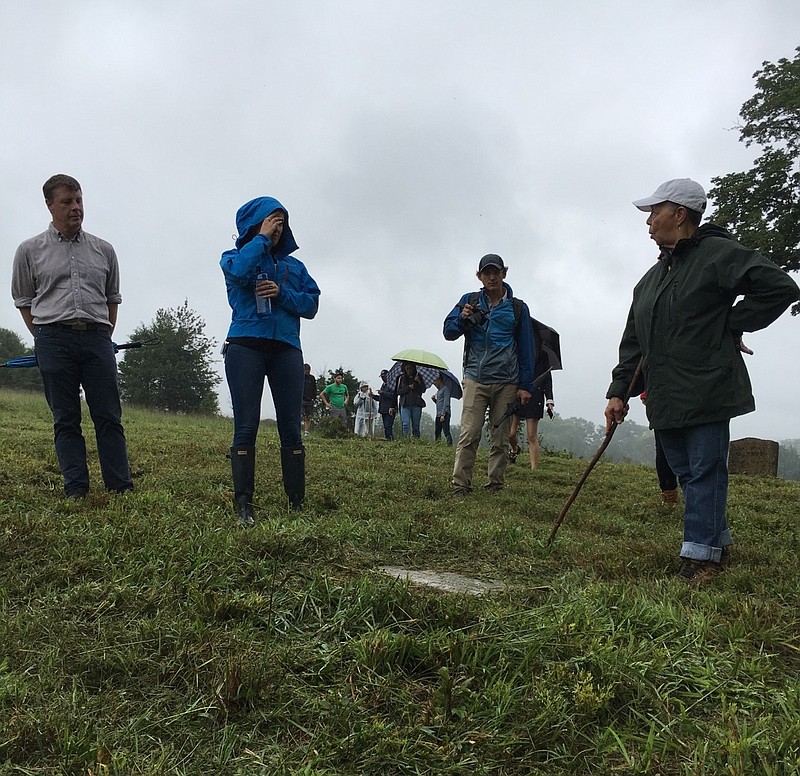The life of Mark Thrash is known to history. A former slave, he was groundskeeper for the Chickamauga Battlefield through the late 1800s and early 1900s, burying Union and Confederate soldiers and dazzling visitors with his stories of life before the Civil War. A Google search of his name turns up book ads, news reports, Civil War forums, personal blogs, even Flickr accounts.
While his life lives on through these accounts, his final resting place is a bit murkier.
Thrash is one of hundreds of people buried in District Hill Cemetery in Chickamauga. The cemetery was designated a "colored" cemetery in the early 1900s by the Gordon Lee family, and was in use through the 1940s, according to local resident Joyce Harrison. Over the years maintenance stopped, and the roughly 130 African-Americans buried there following the cemetery's public dedication in 1912 have had their headstones and plots lost to history.
Until recently, that is.
Harrison and other area residents have gotten assistance from landscape and architectural graduate students from the University of Georgia's Carl Vinson Institute of Government to potentially restore the cemetery and create headstones for those known to be interred there.
"We have the names of about 130 people, but the tombstones have all been turned over and lost in disarray," said Harrison, whose grandfather purchased the farm adjacent to the cemetery in 1915.
Legal documents from the era indicate that prior to becoming a public cemetery, hundreds of slaves were buried there in unmarked graves. While the exact location of those bodies would be impossible to determine without digging up the land, Harrison said the plots of the 130 people buried after the cemetery was dedicated can still be restored.
Among those is Thrash, at one point the oldest person in the country before passing away in 1943, just short of his 123rd birthday.
A few years ago, Harrison was able to acquire grant funding for a ground-penetrating radar project to identify the locations of the roughly 130 people buried there following the cemetery's dedication. The radar locates bodies by detecting pockets of air in their coffins, so the 700-1,000 slaves buried in mass graves could only be found by digging up the land, she said.
Now, with the help of UGA students, Harrison and the community hope to restore the cemetery so family members and descendants can visit the graves of their relatives. The students will be creating a landscaping and construction plan to restore the cemetery while maintaining the dignity of the original space.
Friendship Missionary Baptist Church in Chickamauga is also providing assistance, Harrison said. The church holds the archives of African-American cemeteries in the area, and Harrison said the congregation has also been invaluable thus far in the planning and fundraising.
The project was started decades ago by Harrison's father, the late Willie Haslerig. He cleared the space of trees, overgrowth and debris and collected the names of every person buried there that he could find through church archives and local families.
"The people who really built Chickamauga are buried there. They should never have been forgotten," Harrison said. "They lived here and toiled here, and we need to respect that. We don't give enough recognition to the enslaved - it's important to fill in the blanks of our history."
At the end of the current academic semester, the students will compile their plans and present them to Harrison and the community. With a concrete plan in place, Harrison hopes grant funding can be secured to make the construction and landscaping a reality. The students have already started work with Trent Wichman of Wichman Monuments in Chattanooga to design a tombstone for the currently unmarked graves, she said.
Harrison also thanked state Sen. Jeff Mullis for arranging a cleanup of the site in preparation for the ground-penetrating radar project, and John Culpepper and the Georgia Civil War Commission for providing the original funding.
She said it's important to create a hallowed ground that family and friends can visit with dignity.
"We're very excited about what could happen moving forward," Harrison said.
Anyone who would like to help with the restoration can donate to Friendship Missionary Baptist Church or call Joyce Harrison at 203-981-6826.
Email Shane Foley at sfoley@timesfreepress.com.
